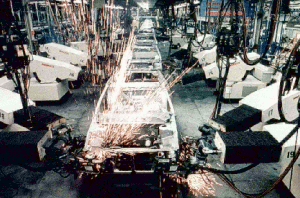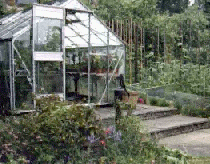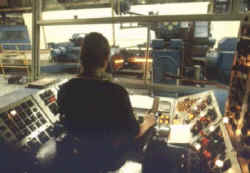| Control Systems | ||||||
The signals sent by a computer to a device are called control signals. They may be in the form of
An output port is a connecting point on a computer through which it can send control signals. A relay is a switch which can be switched on and off by an electrical signal. It can be used in the device being controlled to switch lights and motors on and off. An actuator is a device which can produce a movement when given an electrical signal. It receives the control signals and converts them into movement. An interface is some hardware, and possibly also some software, that is used to connect two devices or systems to enable them to communicate. Control systems often need interfaces between the computer and the controlled device. This happens if the type of signal sent or received by the computer is not the same type as that of the device. In particular the interface may need to include analogue-to-digital or digital-to-analogue converters. A digital-to-analogue converter is an interface to convert a digital signal to an analogue one. It converts a set of binary signals to one single varying voltage. An analogue-to-digital converter is an interface to convert an analogue signal (eg from a sensor) to a digital one (for the computer).
|
||||||
|
Sensors and feedback A simple control system can work by a processor sending control signals to a device which then responds accordingly. However, in most control systems the computer also receives signals back. These help the processor to decide what to do next. Such signals come from:
A sensor is a monitoring device which measures some physical quantity and sends signals back to the processor. An input port is a connecting point on a computer through which it can receive signals from sensors and switches. Examples of sensors
Feedback generally means using output from a system to influence the input. Data from sensors is received by the processor and these data help it to decide what control signals to send. The processor uses feedback to keep the control system stable. Components of a control system. A control system normally requires a processor which has:
|
||||||
|
Application of sensors and feedback. Automatic control of a greenhouse.
Data Capture - The greenhouse has suitably placed sensors to measure -
The temperature sensor is digital but the humidity sensor is analogue. Role of the computer - The computer receives readings from the sensors. Readings from the humidity sensor are passed through an analogue-to-digital converter. It is programmed to check humidity and temperature at 10-second intervals and take appropriate actions eg.
|
||||||
|
Process control
|
||||||
|
Application involving process control. Control of gas pipelines and pumping stations. The situation - As consumers use gas, the pressure has to be maintained at a fixed level throughout the grid. This is done by pumping gas to those areas where the pressure is dropping. Data capture - each pumping station has a microprocessor and pressure sensors. Signals are sent from these by microwaves. The role of the computer - The whole grid is controlled by a computer at the board's headquarters. It sends a microwave signal to a pumping station asking for pressure readings. The microprocessor there sends results back. These are analysed and the main computer sends signals to the microprocessor to adjust the pumps.
|
||||||
|
Data logging. Data logging is the automatic recording of data as it is produced. Characteristics of a data logging system
|
||||||
|
APPLICATION: involving data logging Monitoring conditions inside a petrochemical plant Data capture - Sensors monitor the temperature in the boiler, the flow at two critical points and the output produced by the plant. The role of the computer - The computer takes a sample of each of the four readings at one minute intervals. These values are stored in a disc file. Graphs of each of the readings are displayed all the time on the computer's screen. The four graphs are adjusted each minute to take account of the new reading. Each hour, the values stored are used to produce statistics of the performance of the plant.
|
||||||




